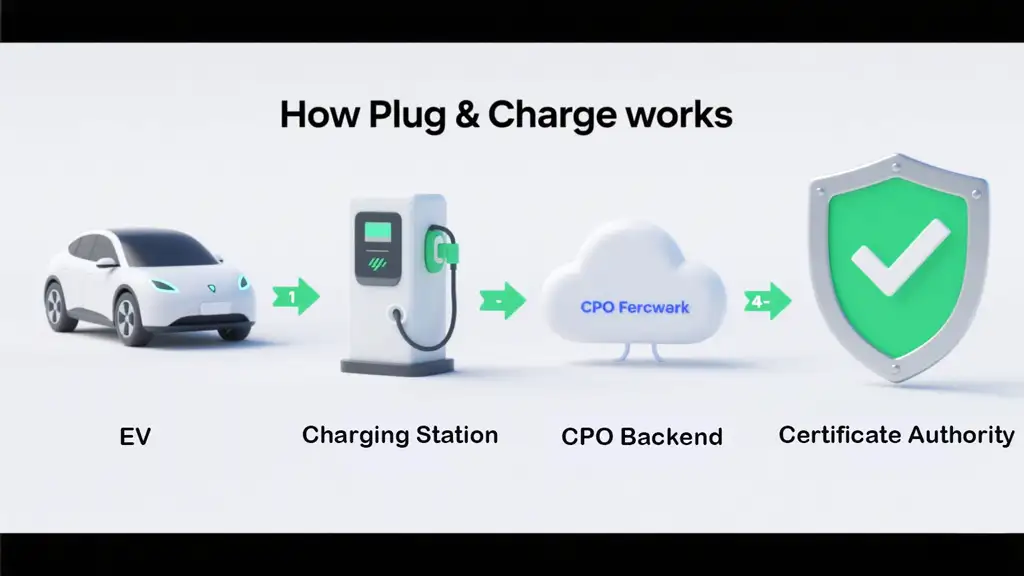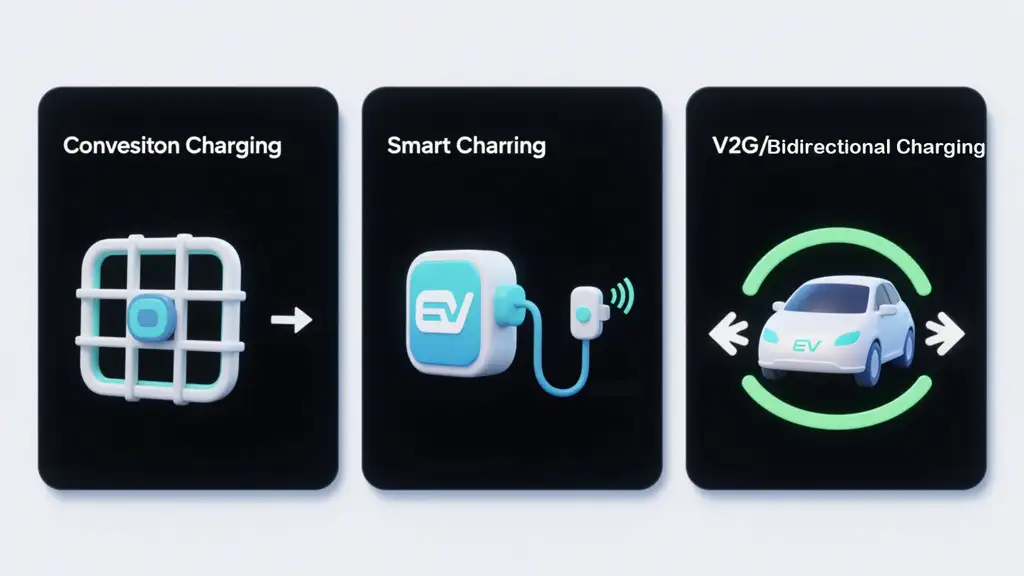Imagine pulling into a charging station, plugging in your electric vehicle (EV), and walking away. No apps, no credit cards, no RFID fobs. The charger automatically identifies your vehicle, authenticates your account, and starts billing. When you return, your car is charged and ready to go.
This seamless experience isn’t a distant dream. It’s happening now, and the technology making it possible is called ISO 15118.
This article is your ultimate guide to understanding this transformative standard. We will break down what ISO 15118 is, how it enables powerful features like Plug & Charge and V2G, and why it is the foundational language for the future of electric mobility. Whether you are an engineer, a business leader, you will find the clear answers you need right here.
In the simplest terms, ISO 15118 is an international standard that defines how electric vehicles talk to charging stations. Think of it as a universal, secure digital language. It creates a direct, two-way communication link between the vehicle’s internal computer and the charging equipment, known as the Electric Vehicle Supply Equipment (EVSE).
This is a huge leap from older, simpler charging methods. Traditional chargers just send power. They don’t really communicate. But with ISO 15118, the car and the charger have a sophisticated conversation. They exchange complex information about identity, grid status, battery levels, and payment, paving the way for a host of advanced functions.
This standard is more than just a technical update; it creates value for everyone in the EV ecosystem. Its adoption is critical for unlocking the full potential of electric transportation. The International Energy Agency (IEA) reports that the number of EVs on the road is projected to reach over 240 million by 2030, putting immense pressure on our power grids. ISO 15118 provides the intelligent framework needed to manage this growth.
Seamless Experience: The flagship feature, Plug & Charge, eliminates the need for any manual payment or authentication steps.
Interoperability: Drivers are no longer locked into a single charging network. Any ISO 15118-compliant charger will work seamlessly with their vehicle.
Enhanced Security: The standard uses sophisticated digital certificates to protect user data and prevent fraud, a massive improvement over insecure RFID cards.
Higher Utilization: The simplicity of Plug & Charge encourages more drivers to use the station, increasing revenue.
Smart Charging Revenue: CPOs can offer smart charging services, managing charging schedules to take advantage of lower electricity prices and passing the savings to customers.
Future-Proofing: Implementing ISO 15118 prepares a network for future innovations like bidirectional charging, where CPOs can earn money by helping stabilize the grid.
Grid Stabilization: With V2G, EVs can become a vast, distributed energy resource. During peak demand, millions of parked EVs could send small amounts of power back to the grid, preventing blackouts.
Renewable Energy Integration: Solar and wind power are intermittent. Smart charging allows EVs to soak up excess renewable energy when it’s abundant (e.g., midday sun) and reduce their load when it’s scarce.
Reduced Infrastructure Costs: By intelligently managing when and how cars charge, utilities can defer expensive upgrades to substations and power lines.

ISO 15118 enables two revolutionary features that fundamentally change what an EV can do.
Plug & Charge is exactly what it sounds like. It is the automated process of authentication and billing that occurs the moment you plug your car into a compatible charger.
How does it work?
The magic happens through a technology called Public Key Infrastructure (PKI), the same security framework that protects online banking and e-commerce.
Digital Certificate: Your car manufacturer (OEM) installs a unique, tamper-proof digital “passport” or contract certificate in your vehicle. This certificate is tied to your payment account.
The Handshake: When you plug in, the car presents this certificate to the charger.
Verification: The charger sends the certificate to its operator’s backend system. The system verifies the certificate’s authenticity with a trusted “root” Certificate Authority (CA).
Authorization: Once verified, the charger is authorized to start the flow of electricity and bill the associated account automatically. The entire process is secure and takes only a few seconds.
Smart Charging is the ability to remotely control the charging process. It allows the vehicle and charger to adjust the charging speed and schedule based on external signals, such as electricity prices or grid demand. This is the foundation for a much more powerful concept: V2G.
V2G, which stands for Vehicle-to-Grid, is enabled by bidirectional charging. This means power can flow not only from the grid to the car, but also from the car back to the grid. An EV is essentially a large battery on wheels. With a typical battery size of 60 kWh, it can power an average home for one to two days. V2G harnesses this stored energy.
Peak Shaving: During peak energy demand (e.g., 5 PM on a hot day), a V2G-enabled EV can stop charging or even discharge a small amount of power to help stabilize the grid. The owner is often compensated for providing this service.
Ancillary Services: The EV can help regulate grid frequency and voltage, sophisticated services that utilities pay a premium for.
Vehicle-to-Home (V2H): During a power outage, the car can power the owner’s home directly, acting as a backup generator.

| Feature | ISO 15118-2 | ISO 15118-20 |
|---|---|---|
| Primary Goal | Enable secure AC/DC charging & Plug & Charge | Create a unified standard for all charging, including full V2G |
| Energy Flow | Unidirectional (Smart Charging). Basic V2G possible but limited | Fully Bidirectional Charging (V2G, V2H, V2L) is natively supported |
| Charging Methods | Wired AC & DC Charging (via CCS) | Adds Wireless Charging & Pantograph Charging (for buses/trucks) |
| Security | TLS 1.2 protocol for secure communication | Upgraded to more robust TLS 1.3 protocol |
| Data Throughput | Lower data transfer rate | Significantly higher data throughput, enabling more complex services |
| Use Cases | Basic smart charging, automated authentication | Advanced grid services, powering homes (V2H), powering tools (V2L) |
For this standard to work, several key players must communicate flawlessly using its language. It creates an interconnected web of hardware and software.
Adopting ISO 15118 requires a coordinated effort across hardware and software.
Your equipment needs a communication controller—a “brain”—that can speak the ISO 15118 language. This controller manages the high-level communication link over the power line (known as Power Line Communication or PLC). It must also have a secure element to protect the cryptographic keys used for authentication.
Your backend system, often called a Charging Station Management System (CSMS), needs to be ready. This means supporting protocols like OCPP 2.0.1, which is designed to work hand-in-hand with ISO 15118. Your system must be able to communicate with Certificate Authorities, manage charging sessions, and process the complex data streams from smart charging and V2G events. According to organizations like the Open Charge Alliance, the synergy between ISO 15118 (vehicle-to-station) and OCPP (station-to-backend) is essential.
ISO 15118 is far more than a technical document. It is the digital backbone for a clean, efficient, and user-friendly electric transportation ecosystem. It solves the biggest pain points for drivers today while unlocking the immense value of EVs as grid-stabilizing assets for tomorrow.
By enabling three key pillars—Security, Intelligence, and Convenience—this standard paves the way for mass EV adoption. It ensures that the transition to electric mobility is not only sustainable but also smart. As bidirectional charging and V2G move from concept to reality, the language they will all be speaking is ISO 15118. Understanding it is understanding the future of energy and transportation.
Ready to future-proof your EV charging solutions? Our team of experts specializes in ISO 15118 implementation. Contact us for a consultation or download our latest whitepaper on navigating the V2G landscape.
Authoritative Sources
International Organization for Standardization (ISO): The official page for the ISO 15118 series, where you can find all parts, including the latest publications.
International Energy Agency (IEA): The landing page for the IEA’s work on electric vehicles, featuring the most recent “Global EV Outlook” report. As of now, the 2025 report is the most current.
Charging Interface Initiative (CharIN e.V.): The official technology page from CharIN explaining the importance and function of ISO 15118.
We will send detailed technical info and quotation to you!